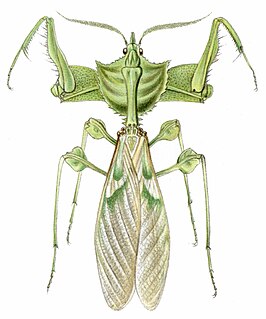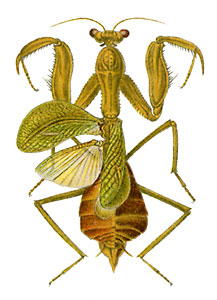
Mantis shrimp, or stomatopods, are carnivorous marine crustaceans of the order Stomatopoda, branching from other members of the class Malacostraca around 340 million years ago. Mantis shrimps typically grow to around 10 cm (3.9 in) in length, while a few can reach up to 38 cm (15 in). The largest mantis shrimp ever caught had a length of 46 cm (18 in); it was caught in the Indian River near Fort Pierce, Florida, in the United States. A mantis shrimp's carapace covers only the rear part of the head and the first four segments of the thorax. Varieties range in color from shades of brown to vivid colors, with more than 450 species of mantis shrimps being known. They are among the most important predators in many shallow, tropical and subtropical marine habitats. However, despite being common, they are poorly understood, as many species spend most of their lives tucked away in burrows and holes.

Phyllocrania paradoxa, common name ghost mantis, is a small species of mantis from Africa remarkable for its leaf-like body. It is one of the three species in the genus Phyllocrania. It is known for its distinct and exclusive camouflaged appearance of a dry weathered leaf.
Amorphoscelis elegans is a species of praying mantis found in Ethiopia, Somalia, and Tanzania.

Blepharopsis mendica is a species of praying mantis found in North Africa, parts of the Mediterranean, Middle East and southern Asia, and on the Canary Islands. Devil's flower mantis, Egyptian flower mantis, thistle mantis, and Arab mantis are among its common names.

Idolomantis is a genus of praying mantises in the family Empusidae. It is represented by a single species, Idolomantis diabolica, commonly known as the devil's flower mantis or giant devil's flower mantis. It is one of the largest species of praying mantises, and is possibly the largest that mimics flowers
Hoplocorypha salfii is a species of praying mantis found in Ethiopia and Somalia.

Cilnia humeralis, common name wide-armed mantis, is an aggressive and very cannibalistic species of praying mantis from Africa.
Sphodromantis fenestrata is a species of praying mantis found in Ethiopia, Kenya, Somalia, Sudan, and Tanzania.
Sphodromantis rudolfae is a species of praying mantis found in Ethiopia, Kenya, Somalia, and Zanzibar.
Sphodromantis abessinica is a species of praying mantis found in Ethiopia and Somalia.
Sphodromantis pachinota is a species of praying mantis found in Ethiopia and Sudan.
Sphodromantis citernii is a species of praying mantis found in Ethiopia and Somalia.
Sphodromantis elegans is a species of praying mantis found in Ethiopia, Burkina Faso, Guinea, Mauritania, Niger, Senegal and the Congo River region.
Oxyophthalmellus somalicus is a species of praying mantis found in Ethiopia, Kenya, Somalia, and Tanzania.
Pyrgomantis ornatipes is a species of praying mantis found in Ethiopia.
Junodia amoena is a species of praying mantis found in Ethiopia, Kenya, Mozambique, and Tanzania.
Junodia hararensis is a species of praying mantis found in Ethiopia and Somalia.
Junodia strigipennis is a species of praying mantis found Ethiopia, Mozambique, South Africa, Tanzania, and Zimbabwe. It was previously identified as Oxypilus strigipennis.

Mantises are an order (Mantodea) of insects that contains over 2,400 species in about 430 genera in 30 families. The largest family is the Mantidae ("mantids"). Mantises are distributed worldwide in temperate and tropical habitats. They have triangular heads with bulging eyes supported on flexible necks. Their elongated bodies may or may not have wings, but all Mantodea have forelegs that are greatly enlarged and adapted for catching and gripping prey; their upright posture, while remaining stationary with forearms folded, has led to the common name praying mantis.






